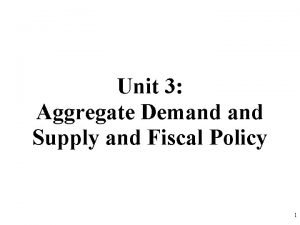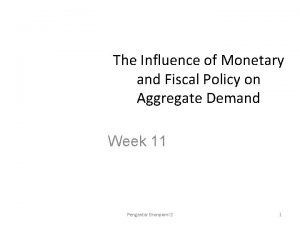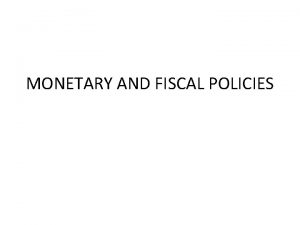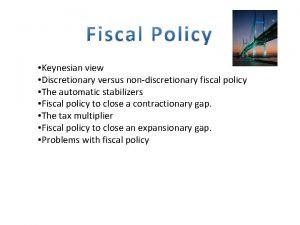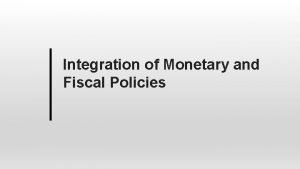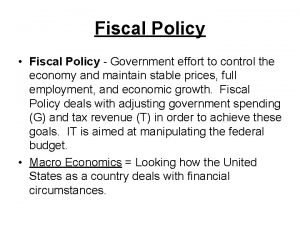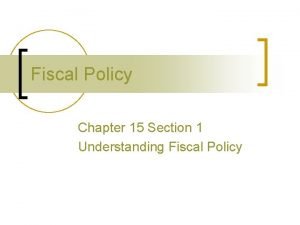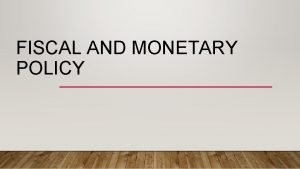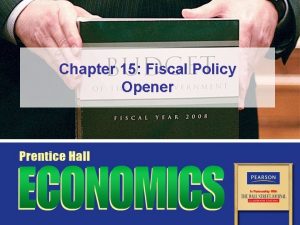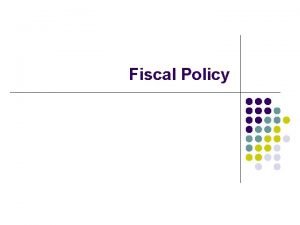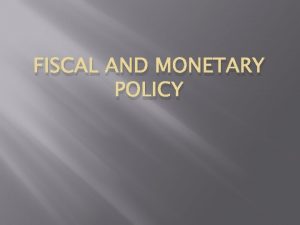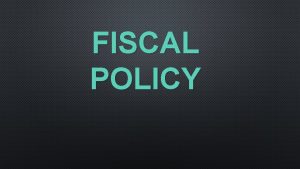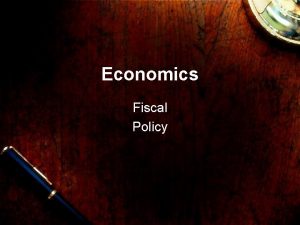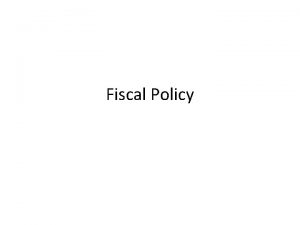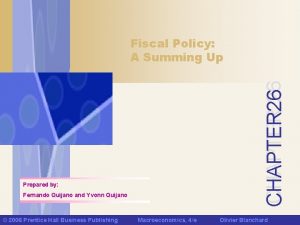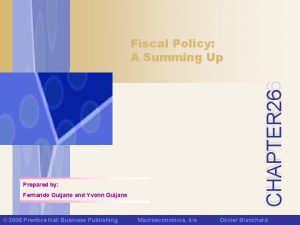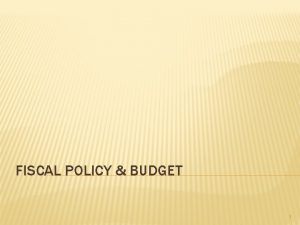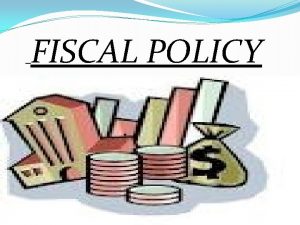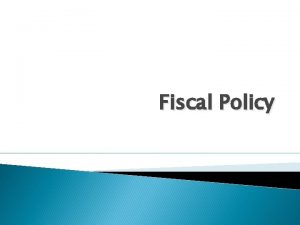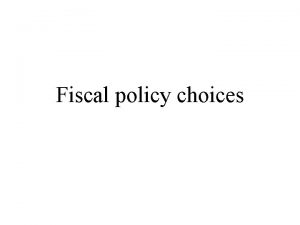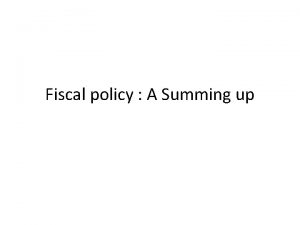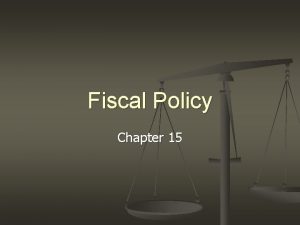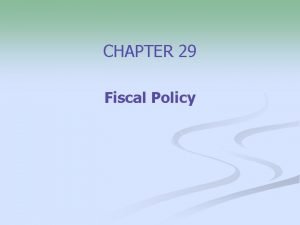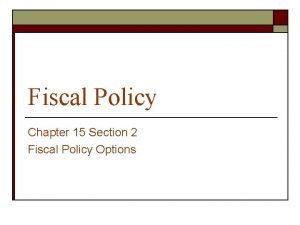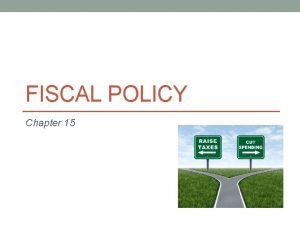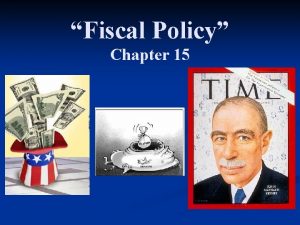CHAPTER 26 Fiscal Policy A Summing Up Prepared













































- Slides: 45

CHAPTER 26 Fiscal Policy: A Summing Up Prepared by: Fernando Quijano and Yvonn Quijano © 2006 Prentice Hall Business Publishing Macroeconomics, 4/e Olivier Blanchard

Chapter 26: Fiscal Policy: A Summing Up 26 -1 The Government Budget Constraint Suppose that, starting from a balanced budget, the government cuts taxes, creating a budget deficit. What will happen to debt over time? Will the government need to increase taxes later? If so, by how much? © 2006 Prentice Hall Business Publishing Fiscal Policy: What You Have Learned and Where In this chapter we look further at the implications of the budget constraint facing the government and discuss current issues of fiscal policy in the US. Macroeconomics, 4/e Olivier Blanchard 2

Chapter 26: Fiscal Policy: A Summing Up The Arithmetic of Deficits and Debt The budget deficit in year t equals: is the government debt at the end of year t-1. is government spending during year t. is taxes minus transfers during year t. In words: The budge deficit equals spending, including interest payments on the debt, minus taxes net of transfers. © 2006 Prentice Hall Business Publishing Macroeconomics, 4/e Olivier Blanchard 3

Chapter 26: Fiscal Policy: A Summing Up The Arithmetic of Deficits and Debt Note two characteristics of § We measure interest payments as real interest payments rather than as actual interest payments. The correct measure of the deficit is sometimes called the inflationadjusted deficit. § G does not include transfer payments. © 2006 Prentice Hall Business Publishing Macroeconomics, 4/e Olivier Blanchard 4

Chapter 26: Fiscal Policy: A Summing Up The Arithmetic of Deficits and Debt The government budget constraint states that the change in government debt during year t is equal to the deficit during year t: It is often convenient to decompose the deficit into the sum of two terms: § Interest payments on the debt, r. Bt-1 § The difference between spending and taxes, Gt-Tt. This term is called the primary deficit (equivalently, Tt –Gt is called the primary surplus). © 2006 Prentice Hall Business Publishing Macroeconomics, 4/e Olivier Blanchard 5

Chapter 26: Fiscal Policy: A Summing Up The Arithmetic of Deficits and Debt change in the debt interest payments Primary deficit Or: © 2006 Prentice Hall Business Publishing Macroeconomics, 4/e Olivier Blanchard 6

Chapter 26: Fiscal Policy: A Summing Up Inflation Accounting and the Measurement of Deficits Figure 1 Official and Inflation. Adjusted Budget Deficits for the United States, 19682004 © 2006 Prentice Hall Business Publishing Macroeconomics, 4/e Olivier Blanchard 7

Chapter 26: Fiscal Policy: A Summing Up Current Versus Future Taxes Let’s look at the implications of a 1 -year decrease in taxes for the path of debt and future taxes. We start with a balanced budget, and end the year with the government decreasing taxes by 1 for 1 year. What happens thereafter? © 2006 Prentice Hall Business Publishing Macroeconomics, 4/e Olivier Blanchard 8

Chapter 26: Fiscal Policy: A Summing Up Full Repayment in Year 2 Replacing B 2=0 and B 1=1, and rearranging: In words, to repay the debt fully in year 2, the government must run a primary surplus equal to (1+r). © 2006 Prentice Hall Business Publishing Macroeconomics, 4/e Olivier Blanchard 9

Chapter 26: Fiscal Policy: A Summing Up Full Repayment in Year 2 Figure 26 - 1 Tax Cuts, Debt Repayment, and Debt Stabilization (a) If debt is fully repaid during year 2, the decrease in taxes of 1 in year 1 requires an increase in taxes equal to (1+r) in Year 2. © 2006 Prentice Hall Business Publishing Macroeconomics, 4/e Olivier Blanchard 10

Chapter 26: Fiscal Policy: A Summing Up Full Repayment in Year 2 Figure 26 - 1 Tax Cuts, Debt Repayment, and Debt Stabilization (b) If debt is fully repaid during year 5, the decrease in taxes of 1 in year 1 requires an increase in taxes equal to (1+r)4 during year 5. © 2006 Prentice Hall Business Publishing Macroeconomics, 4/e Olivier Blanchard 11

Chapter 26: Fiscal Policy: A Summing Up Full Repayment in Year 2 Figure 26 - 1 Tax Cuts, Debt Repayment, and Debt Stabilization (c) If debt is stabilized from Year 2 on, then taxes must be permanently higher by r from Year 2 on. © 2006 Prentice Hall Business Publishing Macroeconomics, 4/e Olivier Blanchard 12

Chapter 26: Fiscal Policy: A Summing Up Full Repayment in Year t Debt at the end of year t 1 is given by: In year t, when the debt is repaid, the budget constraint is: Debt at the end of year t equals zero: which implies that the necessary surplus in year t to repay the debt must be: © 2006 Prentice Hall Business Publishing Macroeconomics, 4/e Olivier Blanchard 13

Chapter 26: Fiscal Policy: A Summing Up Full Repayment in Year t Our first set of conclusions: § If government spending is unchanged, a decrease in taxes must eventually be offset by an increase in taxes in the future. § The longer the government waits to increase taxes, or the higher the real interest rate, the higher the eventual increase in taxes. © 2006 Prentice Hall Business Publishing Macroeconomics, 4/e Olivier Blanchard 14

Chapter 26: Fiscal Policy: A Summing Up Debt Stabilization in Year t From constraint for year 2 is , the budget Under our assumption that debt is stabilized in Year. Replacing in the preceding equation: Reorganizing and bringing side: © 2006 Prentice Hall Business Publishing Macroeconomics, 4/e to the left Olivier Blanchard 15

Chapter 26: Fiscal Policy: A Summing Up Debt Stabilization in Year t From the preceding arithmetic of deficits and debt we can draw these conclusions: If government spending is unchanged, a decrease in taxes must eventually be offset by an increase in taxes in the future. The longer the government waits to increase taxes or the higher the real interest rate, the higher the eventual increase in taxes. © 2006 Prentice Hall Business Publishing Macroeconomics, 4/e Olivier Blanchard 16

Chapter 26: Fiscal Policy: A Summing Up Debt Stabilization in Year t From the preceding arithmetic of deficits and debt we can draw these conclusions: § The legacy of past deficits is higher government debt. § To stabilize the debt, the government must eliminate the deficit. § To eliminate the deficit, the government must run a primary surplus equal to the interest payments on the existing debt. This requires higher taxes forever. © 2006 Prentice Hall Business Publishing Macroeconomics, 4/e Olivier Blanchard 17

Chapter 26: Fiscal Policy: A Summing Up The Evolution of the Debt-to-GDP Ratio In an economy in which output grows over time, it makes sense to focus on the ratio of debt to output. The debt-to-GDP ratio, or debt ratio gives the evolution of the ratio of debt to GDP. © 2006 Prentice Hall Business Publishing Macroeconomics, 4/e Olivier Blanchard 18

Chapter 26: Fiscal Policy: A Summing Up The Arithmetic of the Debt Ratio To derive the evolution of the debt ratio takes a few steps. Do not worry: The final equation is easy to understand. © 2006 Prentice Hall Business Publishing Macroeconomics, 4/e Olivier Blanchard 19

Chapter 26: Fiscal Policy: A Summing Up The Arithmetic of the Debt Ratio This took many steps, but this final relation has a simple interpretation: § The change in the debt ratio over time is equal to the sum of two terms. § The first term is the difference between the real interest rate and the growth rate times the initial debt ratio. § The second term is the ratio of the primary deficit to GDP. © 2006 Prentice Hall Business Publishing Macroeconomics, 4/e Olivier Blanchard 20

Chapter 26: Fiscal Policy: A Summing Up The Evolution of the Debt Ratio in OECD Countries This equation implies that the increase in the ratio of debt to GDP will be larger: § the higher the real interest rate, § the lower the growth rate of output, § the higher the initial debt ratio, § the higher the ratio of the primary deficit to GDP © 2006 Prentice Hall Business Publishing Macroeconomics, 4/e Olivier Blanchard 21

Chapter 26: Fiscal Policy: A Summing Up The Evolution of the Debt-to-GDP Ratio in OECD Countries § In the 1960 s, GDP growth was strong. As a result, r g was negative. Countries were able to decrease their debt ratios without having to run large primary deficits. § In the 1970 s, r g was again negative due to very low interest rates, leading to a further decrease in the debt ratio. © 2006 Prentice Hall Business Publishing Macroeconomics, 4/e Olivier Blanchard 22

Chapter 26: Fiscal Policy: A Summing Up The Evolution of the Debt-to-GDP Ratio in OECD Countries § In the 1980 s, real interest rates increased and growth rates decreased, thus, debt ratios increased rapidly. § Throughout the 1990 s, interest rates remained high and growth rates low. However, most countries ran primary surpluses sufficient to imply a steady decline in their debt ratios. § So far, during the 2000 s, real interest rates are low, but many countries are running primary deficits, and their debt ratios are again going up. © 2006 Prentice Hall Business Publishing Macroeconomics, 4/e Olivier Blanchard 23

Chapter 26: Fiscal Policy: A Summing Up The Evolution of the Debt-to-GDP Ratio in OECD Countries Table 26 -1 Debt and Primary Surpluses for the United States, the European Union, and Selected Countries, 1981 -2003 (Percent of GDP) Country Debt/GDP Primary Surplus/GDP 1981 1995 2000 2003 United States 25. 8 49. 2 34. 7 36. 1 -1. 4 European Union 24. 0 53. 5 47. 7 52. 0 0. 3 Italy 56. 4 108. 7 93. 5 2. 3 Belgium 82. 2 125. 2 103. 0 94. 2 5. 5 Greece 26. 1 108. 7 106. 2 103. 0 2. 1 © 2006 Prentice Hall Business Publishing Macroeconomics, 4/e Olivier Blanchard 24

Chapter 26: Fiscal Policy: A Summing Up 26 -2 Four Issues in Fiscal Policy Having looked at the mechanics of the government budget constraint, we can now take up four issues in which this constraint plays a central role. © 2006 Prentice Hall Business Publishing Macroeconomics, 4/e Olivier Blanchard 25

Chapter 26: Fiscal Policy: A Summing Up Ricardian Equivalence The Ricardian Equivalence, further developed by Robert Barro, and also known as the Ricardo. Barro proposition, is the argument that, once the government budget constraint is taken into account, neither deficit nor debt has an effect on economic activity. Consumers do not change their consumption in respond to a tax cut if the present value of aftertax labor income is unaffected. The effect of lower taxes today is cancelled out by higher taxes tomorrow. © 2006 Prentice Hall Business Publishing Macroeconomics, 4/e Olivier Blanchard 26

Chapter 26: Fiscal Policy: A Summing Up Deficits, Output Stabilization, and the Cyclically Adjusted Deficit The fact that budget deficits have adverse effects implies that deficits during recessions should be offset by surpluses during booms. The deficit that exists when output is at the natural level of output is called the fullemployment deficit. Other terms used are midcycle deficit, standardized employment deficit, structural deficit, or cyclically adjusted deficit. © 2006 Prentice Hall Business Publishing Macroeconomics, 4/e Olivier Blanchard 27

Chapter 26: Fiscal Policy: A Summing Up Deficits, Output Stabilization, and the Cyclically Adjusted Deficit § A reliable rule of thumb is that a 1% decrease in output leads automatically to an increase in the deficit of 0. 5% of GDP. § If output is, say 5% below its natural level, the deficit as a ratio of GDP will therefore be about 2. 5% larger than it would be if output was at the natural level of output. This effect of the deficit on economic activity has been called the automatic stabilizer. © 2006 Prentice Hall Business Publishing Macroeconomics, 4/e Olivier Blanchard 28

Chapter 26: Fiscal Policy: A Summing Up Wars and Deficits The economic burden of a war affects consumers and firms differently depending on how the war is paid for. There are two good reasons to run deficits during wars: § The first is distributional. Deficit finance is a way to pass some of the burden of the war to those alive after the war. § The second is more narrowly economic. Deficit spending helps reduce tax distortions. © 2006 Prentice Hall Business Publishing Macroeconomics, 4/e Olivier Blanchard 29

Chapter 26: Fiscal Policy: A Summing Up Passing on the Burden of the Wars lead to large increases in government spending. § Suppose the government relies on deficit finance. With government spending sharply up, there will be a very large increase in the demand for goods. § Suppose instead that the government finances the spending increase through an increase in taxes. Consumption will decline sharply. © 2006 Prentice Hall Business Publishing Macroeconomics, 4/e Olivier Blanchard 30

Chapter 26: Fiscal Policy: A Summing Up Reducing Tax Distortions Very high tax rates can lead to very high economic distortions. People will work less, and engage in illegal, untaxed activities. Tax smoothing is the idea that it is better to maintain a relatively constant tax rate, to smooth taxes. Tax smoothing implies large deficits when government spending is high and small surpluses the rest of the time. © 2006 Prentice Hall Business Publishing Macroeconomics, 4/e Olivier Blanchard 31

Chapter 26: Fiscal Policy: A Summing Up The Dangers of Very High Debt The higher the ratio of debt to GDP, the larger the potential for catastrophic debt dynamics. Expectations of higher and higher debt give a hint that a problem may arise, which will lead to the emergence of the problem, thereby validating the initial expectations. Debt repudiation consists of canceling the debt, in part or in full. © 2006 Prentice Hall Business Publishing Deficits, Consumption, and Investment in the US during WWII By 1944, US government spending on goods and services increased to 45% from 15%! Macroeconomics, 4/e Olivier Blanchard 32

Chapter 26: Fiscal Policy: A Summing Up The U. S. Budget: Current 26 -3 Numbers and Future Prospects We conclude this chapter by looking at current U. S. budget numbers and discussing the issues confronting U. S. fiscal policy, now and in the future. © 2006 Prentice Hall Business Publishing Macroeconomics, 4/e Olivier Blanchard 33

Chapter 26: Fiscal Policy: A Summing Up Current Numbers There are many different definitions of “expenditures, ” “revenues, ” and “deficit”: § Some numbers refer to the budget of the federal Government. Some numbers consolidate the accounts of the federal, state, and local governments. § One set of numbers is based on the government accounting system; another set of numbers is based on the national income accounting system. © 2006 Prentice Hall Business Publishing Macroeconomics, 4/e Olivier Blanchard 34

Chapter 26: Fiscal Policy: A Summing Up Current Numbers Here are the main differences between the government numbers and the NIPA numbers: § The government budget numbers are presented by fiscal year. § The government budget numbers are presented in two categories: “on-budget” and “off-budget. ” § The two accounting systems differ in how they treat the sale of government assets. § They differ in the ways they treat government investment. © 2006 Prentice Hall Business Publishing Macroeconomics, 4/e Olivier Blanchard 35

Chapter 26: Fiscal Policy: A Summing Up Current Numbers Here are the main differences between the government numbers and the NIPA numbers: § The difference between the official and the NIPA measures of the deficit can be positive or negative. § One is gross debt, the sum of the federal government’s financial liabilities. § The other, more relevant number is net debt, or equivalently, debt held by the public. © 2006 Prentice Hall Business Publishing Macroeconomics, 4/e Olivier Blanchard 36

Chapter 26: Fiscal Policy: A Summing Up Current Numbers Table 26 -2 U. S. Federal Budget Revenues and Expenditures, Fiscal Year 2003 (Percent of GDP) Revenues 17. 2 Personal taxes 7. 2 Corporate profit taxes 1. 6 Indirect taxes 0. 8 Social insurance contribution 7. 0 Other 0. 6 Expenditures, excluding interest payments 18. 6 Consumption expenditures 6. 0 Defense 4. 0 Nondefense 2. 0 Transfers 8. 8 Grants to state/local governments 3. 0 Other 0. 8 Primary surplus (1) (+ sign: surplus) -1. 4 Net interest payments (2) 1. 8 Real interest payments (3) 0. 9 Inflation components 0. 9 Official surplus: (1) minus (2) -3. 2 Inflation adjusted surplus: (1) minus (3) -2. 3 Memo item. Debt-to-GDP ratio 36. 1 Source: Survey of Current Business, December 2001. Tables 3 -2 and 3 -7. © 2006 Prentice Hall Business Publishing Macroeconomics, 4/e Olivier Blanchard 37

Chapter 26: Fiscal Policy: A Summing Up Medium-Run Budget Projections Figure 26 - 2 Deficits Projections: Federal Government Deficit, Fiscal years 2003 to 2014 Under current fiscal rules, the deficit nearly disappears by 2014. Under more realistic assumptions about spending and revenues, however, it remains high throughout the period. © 2006 Prentice Hall Business Publishing Macroeconomics, 4/e Olivier Blanchard 38

Chapter 26: Fiscal Policy: A Summing Up The U. S. Budget The Congressional Budget Office (or CBO for short) is a nonpartisan agency of Congress that helps Congress assess the costs and the effects of fiscal decisions. The green line presents projected deficits under current rules. (These are called baseline projections. ) © 2006 Prentice Hall Business Publishing Macroeconomics, 4/e Olivier Blanchard 39

Chapter 26: Fiscal Policy: A Summing Up The Long-Run Challenges: Low Saving, Aging, and Medical Care We just reached the conclusion that U. S. budget deficits are likely to remain high for at least the next decade. There are three reasons why we should worry: low U. S. saving, the aging of America, and the increase in medical costs. © 2006 Prentice Hall Business Publishing Macroeconomics, 4/e Olivier Blanchard 40

Chapter 26: Fiscal Policy: A Summing Up Deficits and the Low U. S. Saving Rate The U. S. saving rate is among the lowest in the OECD. This low saving rate should be a matter of concern. The U. S. is now the largest debtor country in the world and will have to pay large interest payments to the rest of the world for the indefinite future. © 2006 Prentice Hall Business Publishing Macroeconomics, 4/e Olivier Blanchard 41

Chapter 26: Fiscal Policy: A Summing Up Retirement and Medical Care Table 26 -3 Projected Spending on Social Security, Medicare, and Medicaid, 1998 -2060 (Percent of GDP) 2004 2010 2030 2050 Social Security 4. 2 5. 9 6. 2 Medicare/Medicaid 4. 1 4. 8 8. 4 11. 5 Total 8. 3 9. 0 14. 3 17. 6 Source: “The Long-Term Budget Outlook, ” Congressional Budget Office, December 2003. Entitlement programs are programs that require the payments of benefits to all who meet the eligibility requirements established by the law. © 2006 Prentice Hall Business Publishing Macroeconomics, 4/e Olivier Blanchard 42

Chapter 26: Fiscal Policy: A Summing Up Retirement and Medical Care Entitlement spending to GDP is projected to increase for these reasons: § The Aging of America: The old age dependency ratio—the ratio of the population 65 years old or more to the population between 20 and 64 years old—is projected to increase from about 20% in 1998 to above 40% in 2060. § The steadily increasing cost of health care. Even if all expenditures other than transfers were eliminated, projected entitlement spending would still exceed revenues. © 2006 Prentice Hall Business Publishing Macroeconomics, 4/e Olivier Blanchard 43

Chapter 26: Fiscal Policy: A Summing Up Retirement and Medical Care Since 1983, Social Security contributions have exceeded benefits. The Social Security Trust Fund is an account where the surpluses have been accumulating, and now equal 12% of GDP. The Social Security Trust Fund is expected to reach a peak by 2030 and then to decline and become equal to zero by 2045. © 2006 Prentice Hall Business Publishing Macroeconomics, 4/e Olivier Blanchard 44

Chapter 26: Fiscal Policy: A Summing Up Key Terms § § § § § inflation-adjusted deficit government budget constraint primary deficit (primary surplus) debt-to-GDP ratio, debt ratio Ricardian equivalence, Ricardo. Barro proposition full-employment deficit mid-cycle deficit standardized employment deficit structural deficit © 2006 Prentice Hall Business Publishing § § § § cyclically adjusted deficit automatic stabilizer tax smoothing debt repudiation Congressional Budget Office (CBO) baseline projections entitlement programs Social Security Trust Fund Macroeconomics, 4/e Olivier Blanchard 45
 Inflation
Inflation Example fiscal policy
Example fiscal policy Government expenditure multiplier formula
Government expenditure multiplier formula Components of fiscal policy
Components of fiscal policy Crowding out effect of fiscal policy
Crowding out effect of fiscal policy Money market graph expansionary monetary policy
Money market graph expansionary monetary policy Instruments of fiscal policy
Instruments of fiscal policy Discretionary and non discretionary fiscal policy
Discretionary and non discretionary fiscal policy Tools of fiscal policy
Tools of fiscal policy Accelerator effect economics
Accelerator effect economics Fiscal demand side policy
Fiscal demand side policy Fiscal policy to control inflation
Fiscal policy to control inflation Types of fiscal policy
Types of fiscal policy Instruments of fiscal policy
Instruments of fiscal policy Crowding out
Crowding out Demand side fiscal policy definition
Demand side fiscal policy definition Contractionary monetary policy
Contractionary monetary policy Crowding out effect of fiscal policy
Crowding out effect of fiscal policy Example of expansionary fiscal policy
Example of expansionary fiscal policy Iousa worksheet
Iousa worksheet Goals of fiscal policy
Goals of fiscal policy Fiscal vs monetary policy
Fiscal vs monetary policy Goals of fiscal policy
Goals of fiscal policy Fiscal policy
Fiscal policy Unit 3 aggregate demand and aggregate supply
Unit 3 aggregate demand and aggregate supply Tax multiplier formula
Tax multiplier formula Classical unemployment diagram
Classical unemployment diagram Meaning of fiscal policy
Meaning of fiscal policy Conclusion of monetary policy
Conclusion of monetary policy Fiscal policy definition
Fiscal policy definition Fiscal policy
Fiscal policy Unit 3 aggregate demand aggregate supply and fiscal policy
Unit 3 aggregate demand aggregate supply and fiscal policy Flowchart merge symbol
Flowchart merge symbol What is summing junction in flowchart
What is summing junction in flowchart Inverting amplifier
Inverting amplifier Voltage subtractor
Voltage subtractor What's inside an op amp
What's inside an op amp Jacobian
Jacobian Summing point constraint
Summing point constraint Apa itu summing amplifier
Apa itu summing amplifier Op amp circuits examples
Op amp circuits examples Gain of an op amp
Gain of an op amp Summing junction
Summing junction The business plan should be prepared by
The business plan should be prepared by After a node has prepared an lsp it must be disseminated to
After a node has prepared an lsp it must be disseminated to Act 4 questions romeo and juliet
Act 4 questions romeo and juliet

